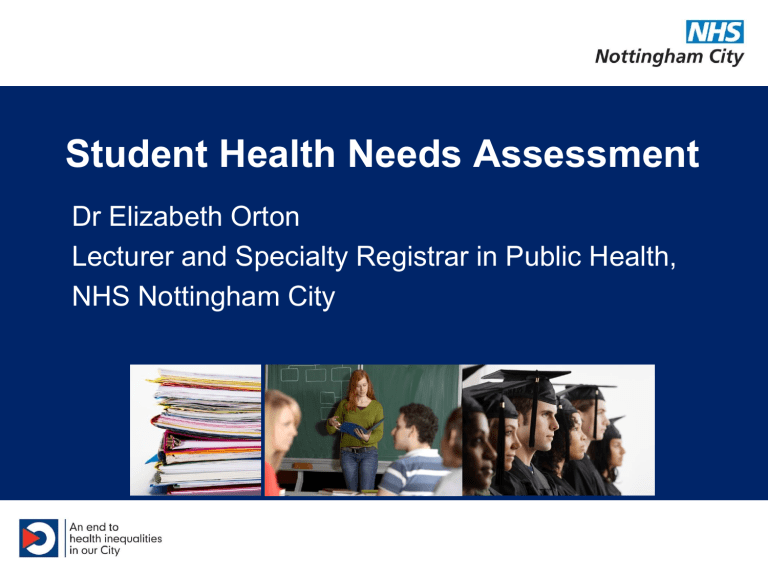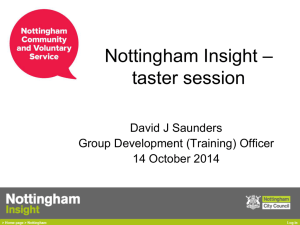Unmet need - The Student Health Association

Student Health Needs Assessment
Dr Elizabeth Orton
Lecturer and Specialty Registrar in Public Health,
NHS Nottingham City
What is a health needs assessment?
Assess population need
Adapt and improve services
Commission services
Are they
Effective?
Audit services
Nottingham Student Health Needs Assessment
– Who is at risk and why
– The level of need in the population
– Current services in relation to need
– Projected service use – next 3/5 years
– Evidence of what works
– User views
– Unmet needs and service gaps
– Recommendations for commissioners
– Who is at risk and why
– The level of need in the population
– Current services in relation to need
– Projected service use – next 3/5 years
– Evidence of what works
– User views
– Unmet needs and service gaps
– Recommendations for commissioners
What makes Students ‘different’?
• Transitory
– Live at ‘home’ and ‘uni’
– Continuity of support networks
– Re-registering with the GP
• May be from overseas
• Live in close proximity
• Health behaviours
– Who is at risk and why
– The level of need in the population
– Current services in relation to need
– Projected service use – next 3/5 years
– Evidence of what works
– User views
– Unmet needs and service gaps
– Recommendations for commissioners
Significant part of Nottingham’s population
• 58,499 university students in 2009/10
• 19% of the population
Accommodation
• Concentrated
G32 G34
Ethnicity
Asian or Asian British - Bangladeshi.
Asian or Asian British - Indian.
Asian or Asian British - Pakistani.
Asian other.
Black or Black British - African.
Black or Black British - Caribbean.
Black other.
Chinese
Other mixed background
Other White background
Other.
White, White - British
White - Irish
White and Asian
White and Black African
White and Black Caribbean
Unknown
% Nottingham City
0.20
2.28
3.64
0.37
0.48
3.44
0.42
% Nottingham Trent
University
0.42
6.95
2.60
1.84
1.63
3.03
0.57
0.64
0.48
2.50
3.64
0.82
0.04
0.47
81.05
1.36
0.47
0.20
1.98
0.00
1.08
66.30
<0.01
0.70
0.37
0.94
9.07
% University of
Nottingham
0.24
6.41
1.20
4.14
2.42
0.58
0.62
8.20
1.28
0.09
2.03
64.89
0.01
1.43
0.57
0.46
5.44
Mental health
• Leeds University needs assessment
– 20% to
30% of undergraduate full-time students above the clinical cut off for requiring counselling
• Financial concerns
•
Additional paid work pressures
• Social support
•
Disadvantaged socio-economic background
Common mental health disorders
GP health system codes
Neurotic disorders
Affective psychosis
Mental + behavioural disorder
Depressed
Depressed mood
Low mood
Prevalence
Denominator Sunrise Radford Cripps
All registered patients aged
18-30
436 959 2077
11% 9% 8%
Comparison with all Nottingham City residents
Counselling services
• RCP report 2011
– Expect 4% of students to use counselling
• 2009/10
– 1541 students/staff seen by University of Nottingham (4.05%)
– 779 students seen at Nottingham Trent University (3.7%)
Smoking
Sunrise
9.4%
Radford
9.6%
Cripps
10%
Nottingham City residents (2011 Survey) 27.5% prevalence
•Take up smoking at uni?
• All recorded at registration?
• Really have a lower prevalence?
Alcohol
Prevalence of high consumption
(audit score over 5)
Sunrise
40%
Radford
41%
Cripps
33%
• Impact of Welcome Week – EMAS 50% increase
Drug use
• No local direct data
• Mosaic suggests G32 and G34 more likely to take cannabis and cocaine
Healthy weight
Prevalence of BMI 31+
Prevalence of BMI 25-30
Sunrise
1.8%
14%
Radford Cripps
3.8% 2.7%
15% 14%
Nottingham City residents (2011 survey)
15.2% obese
30% overweight
Infectious diseases
• Outbreak plans agreed
• MMR catch up at UoN
• All offered MenC
• TB screening at UoN
• Sexual health
– Chlamydia screening (most common STI)
– Sexual health screening (Chlamydia, gonorrhoea, syphilis, HIV)
– C-card scheme
– Who is at risk and why
– The level of need in the population
– Current services in relation to need
– Projected service use – next 3/5 years
– Evidence of what works
– User views
– Unmet needs and service gaps
– Recommendations for commissioners
Unmet need
• International students (and some UK!)
– Unclear about how the NHS works
• Lower smoking cessation uptake
• Differences in City and County service provision
• High alcohol consumption
• Eating disorders (UoN)
• Lack of ethnicity data
• Lack of student-specific data
– Who is at risk and why
– The level of need in the population
– Current services in relation to need
– Projected service use – next 3/5 years
– Evidence of what works
– User views
– Unmet needs and service gaps
– Recommendations for commissioners
Recommendations
• Establish links with NHS and Local Authority commissioners
– Utilise expertise
• Strengthen links with mainstream services
• Monitor equity of services
– TB screening
– Eating disorders services
– Sexual health, smoking cessation and alcohol treatment services (County/City)
• Student-specific data in future?











